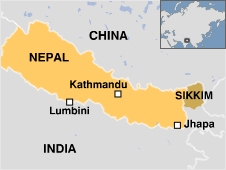Sikkim is the least populous state in India, with just 610,577 residents.![]()
It’s also one of India’s more remote states, nudged in the Himalayan mountains with Chinese Tibet to its north, Nepal to its west and Bhutan to its east. Darjeeling, the town in West Bengal state known so well for the tea of the same name, lies just south of Sikkim. In the colonial period, in fact, Darjeeling was part of Sikkim.
But its state elections will take the spotlight briefly this weekend, when its chief minister Pawan Kumar Chamling tries to win a fifth consecutive term — if he does, he could become the longest-serving chief minister in India’s history.*
Chamling leads the Sikkim Democratic Front (SDF, सिक्किम प्रजातान्त्रिक मोर्चा), which is about as dominant a regional force as you’ll find in India. Not only does it hold Sikkim’s one seat in the national parliament, but it holds every single at in Sikkim’s 32-member legislative assembly.
Chamling founded the SDF in 1993, and it took power in the 1994 state elections. Chamling has controlled Sikkim’s government ever since, steadily dominating Sikkimese government — the SDF’s strength went from just 19 seats in 1994 to 24 seats in 1999 to 31 seats in 2004 to complete dominance.
In the most recent 2009 election, the SDF won all 32 seats in Sikkim’s legislative assembly on the strength on 65.9% of the vote state-wide. Its closest competitor was the Indian National Congress (Congress, भारतीय राष्ट्रीय कांग्रेस), which lost the one seat it previously held in the state assembly, and won just 27.6% of the vote.
In 2014, Chamling’s most serious threat isn’t the Indian National Congress, but a new Sikkim-based party, the Sikkim Krantikari Morcha (SKM, सिक्किम क्रान्तिकारी मोर्चा, Sikkim Revolutionary Front), a party founded in February 2013 by former minister Prem Singh Tamang, who is known widely throughout Sikkim as P.S. Golay. Golay’s opposition to Chamling is essentially personal, not ideological — Golay left the SDF only after Chamling sacked Golay as a minister.
The SKM may make some inroads in the state, on the basis of its charges that Chamling’s governments have become increasingly corrupted. Chamling, in turn, has hurled accusations of violence and terrorism against the SKM after two SDF activists were killed during the election campaign.
Chamling hopes to make Sikkim fully literate by 2015 — and he’s on his way to making Sikkim fully organic by 2015 as well, with all produce grown without chemicals. Though Sikkim is one of India’s poorer states, its economy has grown rapidly over the past decade by harnessing hydroelectric power. The SKM and other opponents have attacked Chamling government for sacrificing the environment for the sake of greater economic development:
Though the ruling Sikkim Democratic Government (SDF) has successfully taken a number of environment protection initiatives in the last two decades of their rule like increasing forest cover and making agriculture organic, they are facing flak for allowing a series of hydropower projects. To tap its rich water resource for generating revenue in the Himalayan state, 4000 MW power generating units are under construction at present while the state government wants to add another 5000 MW capacity….
Buddhist monks are also up in arms against the government contending many such hydropower projects are disturbing the serenity of monasteries which are nestled in peaceful hill forests with rivers flowing nearby. Dechen Lama, a senior monk, complains that a Rs 494 crore power project in West Sikkim is disturbing spiritual activities in Tashiding monastery. “Below the hill they are drilling to make a tunnel for hydropower project. As the monastery is on the top of that hill, our peace is disturbed,” he says.
Most of Sikkim’s residents are ethnically Nepali. Other significant communities include Bhutias and Lepchas, Sikkim’s native ethnicity, and there are reserved seats in Sikkim’s legislative assembly for both ethnic minorities. Around 61% of Sikkim’s residents practice Hinduism, with a significant minority of Buddhists (28%) and Christians (6.5%). Though there are several indigenous languages, Nepali is widely spoken throughout Sikkim, as well as English and Hindi.
At the time of Indian independence in 1947, Sikkim rejected becoming a part of India, though like the rest of India, Sikkim was under British control throughout the 19th century. Sikkim ultimately became a ‘protectorate’ of India with little autonomy over its foreign affairs or defense. It maintained its own monarchy, and the Chogyal of Sikkim, who was nominally Sikkim’s head of state during the British colonial period, nominally remained Sikkim’s head of state for the next three decades. By 1975, however, the monarchy proved unpopular, and Sikkim’s voters instead decided to become a full state within India, thereby abolishing Sikkim’s monarchy.
Nar Bahadur Bhandari, a one-time opponent of Sikkim’s merger with India, quickly emerged as Sikkim’s top power broker, and he served as chief minister between 1979 and 1994, not without controversy over accusations of vote-rigging and corruption. Chamling’s government, however, hasn’t been immune to serious charges of corruption as well in recent years, including the misuse of public funds.
* The record currently belongs to former chief minister Jyoti Basu, a Communist who govered West Bengal between 1977 and 2000.

